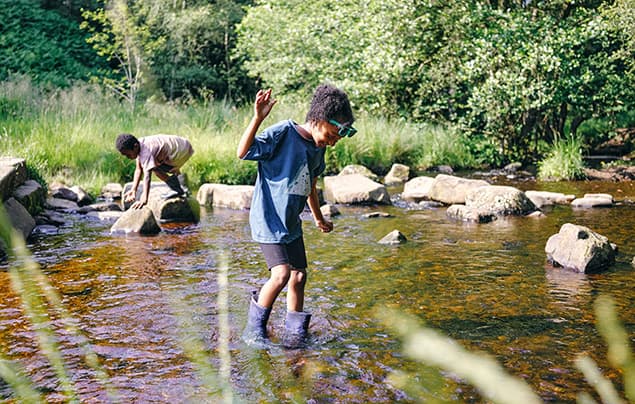Extreme heat might change your kids’ summers. Here’s how to adjust…
Summer just keeps getting hotter. Here’s what that could mean for the future of your child’s annual break.
The northern hemisphere summer of 2023 was the hottest ever recoded, with heatwaves affecting Europe, North America and Asia. Extreme heat, wildfires and droughts exacerbated by the climate crisis are happening more and more – and it’s changing family’s plans.
“Extreme heat is becoming the norm,” says Aaron Bernstein, interim director of the Centre for Climate, Health and the Global Environment at the Harvard T. H. Chan School of Public Health. The changes are developing year on year.
“In general, we’re seeing the summer season expanded a bit, starting sooner and ending later. And we’re seeing the temperatures of the most intense heat days go up,” says Jennifer Vanos, a senior sustainability scientist at Arizona State University.
For kids, more intense temperatures will likely mean a different kind of summer. The days when they could spend most of June, July and August outside might be dwindling. Parents and caregivers will probably have to change routines and activities to keep kids safe outside.
Here’s what a future living with extreme heat might look like – and how parents can make it as fun and normal as possible.
The science behind why extreme heat is dangerous for kids
Extreme heat is defined by doctors as temperatures of 35oC and above. It’s at that point that grown-ups need to limit the time kids spend outside to 30 minutes or less without a break, says paediatrician Ahmad Bailony.
Bailony explains that when it’s hot outside, your body starts to heat up, too. For kids playing outdoors, that means their little muscles are producing even more heat. In normal temperatures, that’s healthy. But too much heat means their blood vessels dilate, which can slow blood flow. As a result, the heart has to work harder to get blood to their organs, including the brain. That’s why an overheated child might seem confused or dizzy, or even faint.
If heat exposure continues, and the body’s core gets higher than 400C, Bailony says heat stroke can set in. In this case, blood struggles even more to pass through a child’s body, depleting other organs of oxygen, which means they can be damaged. In addition, brain tissue can start to break down. This allows protein build-up in the brain, which can cause swelling. If left untreated, heat stroke can lead to organ failure and death.
Many children also struggle to breathe while playing outside in extreme heat. High temperatures and sunlight break down air pollution into ozone, which causes little lungs and airways to swell. And that can lead to another health effect from more intense summers: childhood obesity.
“Kids exercise less because they can’t go outside,” Bailony says. “That’s not a good combination, in a world in which the temperature is rising and people are more out of shape.”
How extreme heat is changing kids’ summers
Scientists expect extremely hot summers to be the new normal, so drastic changes are likely coming for how kids experience the outdoors.
Climate consultant Jamesine Rogers Gibson warns that if extreme summer temperatures continue, kids will have fewer days when they can be safely active outdoors. For example, one study predicted children would experience an increase from 10 days a year when it’s not safe to play outside to 50 days a year by 2050.
That means summer camps and outdoor sports will have to make adjustments. Tiffany Pearsall, the founder of a forest school that runs a summer program for pre-schoolers, already has.
“We didn’t get to go out in the woods very much because just the walk to get there was so hot. I wouldn’t want anyone to be in a heat stroke situation before they got to the cover of the trees,” she says. “There are creeks we like to play in, but it was so hot we couldn’t get there.”
Instead, kids got quick outdoor activities in the morning, before they had to stay inside for the rest of the day. Rogers Gibson says another option might be for camps to meet much earlier in the day. But that will require an adjustment for parents.
Bailony says at this point, all sports teams and outdoor activity leaders should have thermometers on hand to check that kids’ temperatures don’t approach 40oC. But supervisors will also need to establish protocols for when it’s too hot to play.
“They’ll have to have Plan B. That might be moving the activity to a different time of day, a different location, or moving inside, as long as it’s air-conditioned,” Rogers Gibson says. “We’ll also need to train coaches, teachers, helpers, and any other supervising adults to recognise symptoms of heat-related illnesses. They’ll need to know how and when to modify outdoor activities.”
Changing places
Playgrounds might also look different. Although parks are generally cooler because of grass and shady trees, playgrounds can be the hottest parts of a park – “micro heat islands”, according to Vanos. That’s because playgrounds often are not in the shade. They’re also built with materials that absorb more heat, such as metal and rubber.
“And we want to avoid that,” she says. Instead, future playgrounds could use natural products, like heat-absorbing wood chips, she says, and be built with lots of shade – ideally from trees, but also shade sails. Parks and playgrounds could be developed in the path of prevailing winds, to further cool off outdoor spaces.
Another alteration to parks and playgrounds: better lighting in anticipation of the change in play schedules to avoid daytime heat. “You can go to parks after sunset,” she says. “But that means cities need to make sure parks are well lit.”
As summer heat creeps into the months of May and September, school days – as well as classroom facilities – could also be impacted. Already, schools around the world that don’t have air conditioning sometimes have to cancel classes when it’s too hot.
But making up too many of those days becomes problematic, Rogers Gibson says. To prevent lost days (or longer ones, to make up), she predicts that governments will invest money in building cooler schools. For example, some US schools are adding solar panels over parking lots to both provide shade and help power the schools. For family-friendly good news stories like this, plus activities, advice and more, sign up to the National Geographic Kids family newsletter.
Other options for ‘cooler schools’: replacing asphalt with grass or mulch, planting trees for more shade, painting roofs lighter colours that reflect sunlight and don’t absorb as much heat, orientating buildings so they absorb less heat, and better insulating buildings so they’re more efficient.
Cool activities to still have fun outside
Parents and caregivers will have to be creative about finding cool activities that get kids outside when it’s safe. But activity experts who’ve already been dealing with heat waves have plenty of ideas. (Start with these science-based hacks to cool down safely.)
“Children are resilient, and with proper supervision we can keep children safe when the weather gets hot,” Bernstein says.
Amelia McLaughlin, acting director of the Audubon Nature Preschool in Colorado, US, recommends using nearby shade or water, which can be 5 to 8 degrees cooler.
Water lot of fun
Water especially provides lots of opportunities for fun, she says. Stream stomp days are popular at her school, as are bringing buckets and nets to look for crayfish and other small water creatures. You can build a dam with rocks, sand and sticks – but be sure to dismantle it when you leave.
If you aren’t near water, try using sponges to play duck, duck, goose (drips for ducks, bigger squeezes for geese), she says. Bring a hose into a sandpit to explore waterways and dig trenches. Or use the hose to make rainbows.
Keep it chill
Lower-energy activities can also engage kids with the outside world. For instance, Phebe Meyers, community programs senior manager at the Aspen Centre for Environmental Studies, recommends nature-journaling under a tree or watching clouds while lying in the grass. (Here are 20 more ways to bring out your kids’ inner explorer.)
Another activity: bird watching during cooler hours. “That’s not super strenuous and is a good way to get out and do a morning walk.” (Here are some ideas for birding as a family.)
Meyers knows this is the future for her kids. The reality is that their summers will be different from what she experienced. But it’s important for her to figure out how to keep their summers as normal – and as fun – as possible in the face of extreme heat.














LEAVE A COMMENT
THANK YOU
Your comment will be checked and approved shortly.
WELL DONE,
YOUR COMMENT
HAS BEEN ADDED!
COMMENTS1
CUSTOMIZE YOUR AVATAR